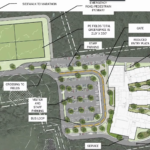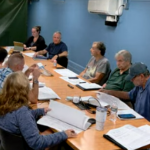Dramatic changes recommended to handle expected increase of students over next decade
The community had a chance to see what the future of the Hopkinton Public School system could look like during a public forum on Dec. 5.
Superintendent Dr. Carol Cavanaugh and representatives of DRA Architectural Firm, the firm hired this year to conduct a capacity study of the current school buildings, presented their recommendations for a 10-year capital plan, which included building a new elementary school, renovating a number of existing schools, and attaching the middle and high school buildings.
With the influx of students in the Hopkinton Public Schools over the past few years, and enrollment predictions of an additional 1,000 students coming into Hopkinton over the next 10 years, space has become a large concern for the district.
The district is looking at a temporary solution of constructing an expansion at the high school of six new classrooms, and purchasing modular classrooms for Elmwood and Hopkins Elementary Schools. Although these new classrooms will help alleviate some of the overcrowding issues currently, future space needs will still need to be taken into consideration, said school officials.
“This work speaks to how Hopkinton would carry through the next 10-15 years,” said James Barrett, principal of DRA.
The first of the two proposed options for the 10-year plan would be for a new three-story Grade 2-5 school built on the Todaro land (on Hayden Rowe Street, just south of Marathon School) that would replace Elmwood School, a renovation of Hopkins Elementary School that would hold Grades 6-7, and connecting the middle and high schools, where Grades 8-9 would be taught on the middle school side and 10-12 on the high school side. The new Grade 2-5 school would keep Grades 2-3 separate from 4-5 but would share a connecting cafeteria and library.
“It would be schools within a school,” said Cavanaugh. Combining the middle and high schools would also allow students in the lower grades the chance to take higher-level coursework while allowing a Grade 8-9 “academy” feel.
The second option is to build two new separate elementary schools — one for Grades 2-3 and one for Grades 4-5. Although it would mean that the grades could have separate spaces, it would increase initial capital and ongoing operational costs as they wouldn’t be able to share resources due to being in different buildings.
Having all of the grades in one school also would save money on transportation expenses, said Cavanaugh, with the town having to pay for two tiers of busing instead of three.
Although a large undertaking, building a big school complex in one area could mean significant reimbursement from the state, and reconfiguring the remaining school buildings could help accommodate the predicted 1,000 additional students that will be coming into Hopkinton over the next 10 years.
After the presentation, the audience was given the chance to ask questions. Questions ranged from the reason for moving ninth grade out of the high school to what the impact would be on traffic if a new 2-5 school was built on Hayden Rowe Street.
To that, Cavanaugh responded that the architects have a plan to build a driveway that would take cars off of the main road to access the school campus.
“That would alleviate a lot of the traffic that is already there,” she said.
Several residents voiced concerns that although there would be additional space, it still might not be enough.
“How do we know that these projections are correct?” asked one community member.
“We have no way of knowing if these are real until we live through this experience,” answered Cavanaugh. “But these projections are based on live birth rates, open land, new housing developments [and pother factors].”
Next steps are to wait until a statement of interest from the district is approved with the Massachusetts School Building Authority. Once approved, it could be upwards of five years before a project could come to completion, which is why it is important to start the process now, said Cavanaugh.
“We need classrooms today,” she said. “It’s time to act.”






















0 Comments